“The core (Dixter) lessons for me are to always be creative, open-minded, curious, and thoughtful…”
🌿 Helen O’Donnell on Great Dixter
Editor’s Note: Welcome to our fifth interview of North American gardeners, each of whom have been deeply influenced by the work of the famed British garden, Great Dixter. For the past year I have been sharing the stories of students, designers, horticultural professionals, and home gardeners about how the practices and qualities of Great Dixter have changed them.
Read a bit about the history and generosity of Great Dixter in the first post of the series.
Gardener & Nursery owner
Today we will hear from Helen O’Donnell. Helen is a gardener, garden designer, printmaker, and co-owner of The Bunker Farm where she runs a specialty annual and perennial nursery in southern Vermont.
I discovered Helen nearly fifteen years ago when she began writing about her UK gardening trips, and now I have many special plants from her nursery growing at Havenwood. I’ve invited Helen to tell us about her learning experiences at Great Dixter a decade ago, and how she has applied her knowledge while gardening and growing at home in the US.
Welcome, Helen!
Julie: How did you find Great Dixter?
Helen: I have been gardening for work (and pleasure) since I was 15 and haven’t missed a gardening season since. It was my summer job in high school and college and after graduation, it was the first paid gig I got after a short three month stint waiting tables. Working in gardens has felt as natural to me as anything. I truly believe humans are all gardeners, it is built into our DNA!
Back in 2010, I had been working for a few years in the garden of Gordon and Mary Hayward and since Gordon is a garden designer and Mary is English, they would travel to England periodically and bring home stories and photos from their time there.
One day they were sharing photos with their gardeners and all of a sudden there were pictures of plants and gardens that sort of stopped me in my tracks—big boisterous, full plantings, teeming with plants in all kinds of surprising combinations, tall and over flowing. In one photo Gordon exclaimed “See that man bent over working amongst the plants in his blue jumpsuit? He is the head gardener, Fergus Garret!” I then impulsively blurted out, “I wonder what it would be like to go and learn from someone like that!” And the rest is history!
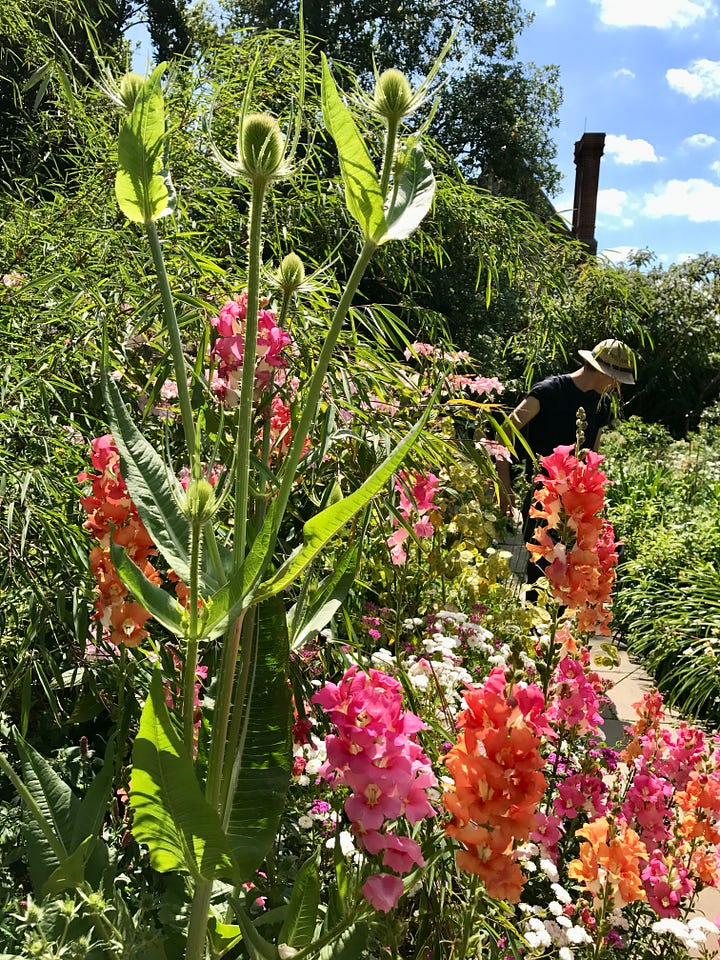


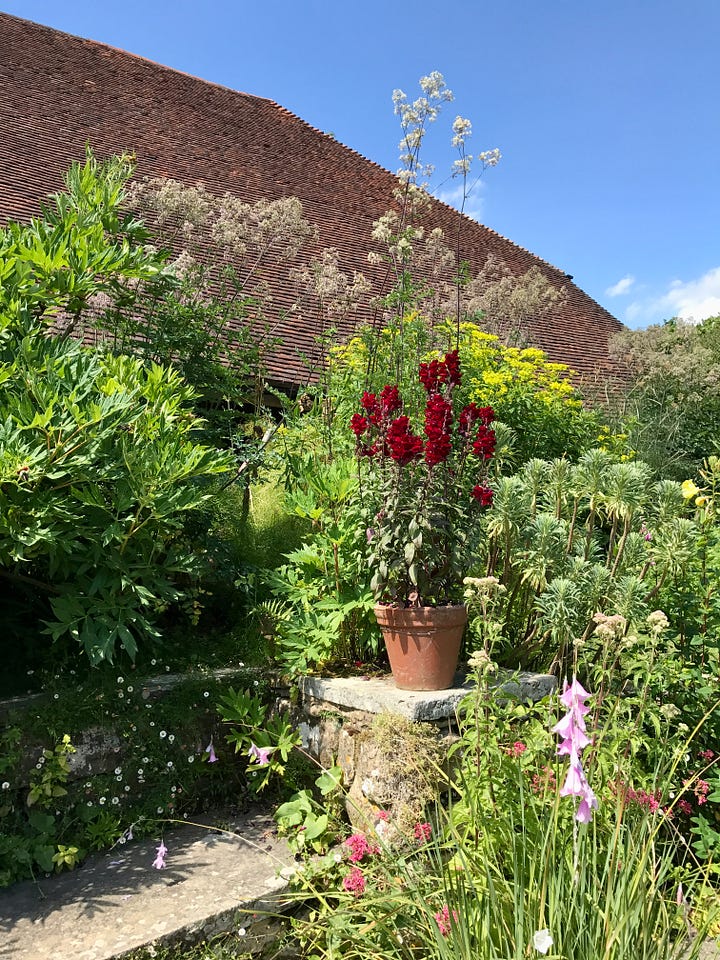
Julie: Do you have a favorite part of the garden or planting at Great Dixter?
Helen: The Barn Garden (above) is a really special place, something about the walled garden, the sunk garden, the water, the space overall is very intimate with particular foundational plantings (such as the trained fig, the big Euphorbias, the Phormium, some really special hydrangeas etc.!) that give that space a really unique feeling. How you can go down inside the garden and look up into the undersides of all the plantings is pretty magical and complicated, you have to garden from so many angles.
For me, I think I love the High Garden (below) maybe the most, the proximity to the sky, the way you look over the rest of the gardens and distant meadows and woodlands. The way the light falls on and across everything at the beginning and the end of the day, the golden hours are best there. Those stock beds are really interesting tucked behind the path ways, you get an impenetrable depth of space and can repeat the really big plants, like the giant fennel, in such satisfying ways (who has a 30’ deep border anyway?), and I love it because it is nearly impossible to garden!
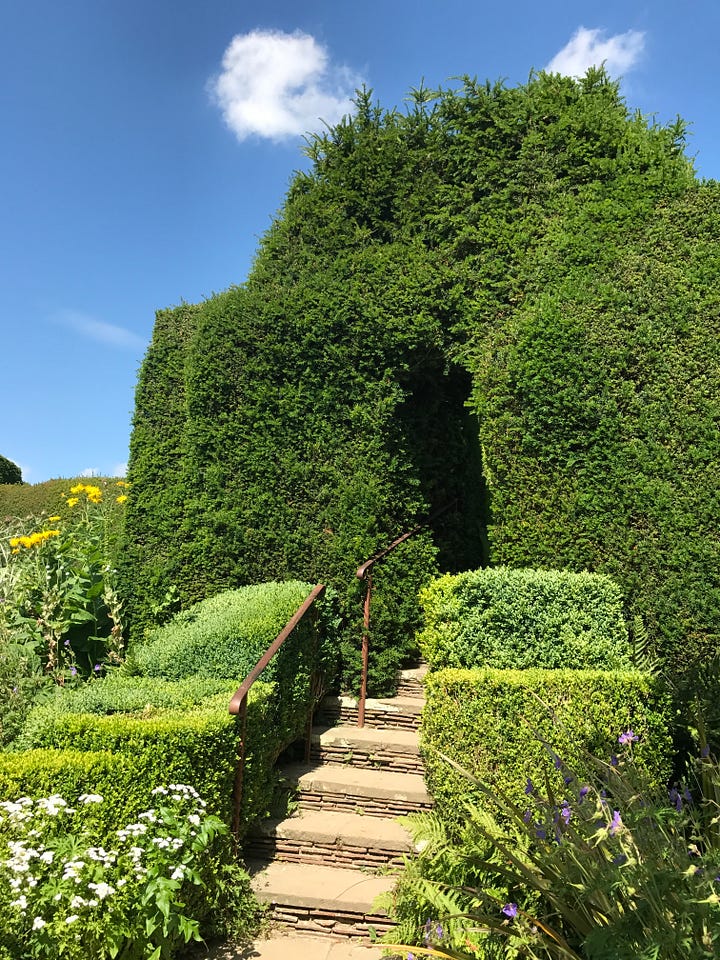

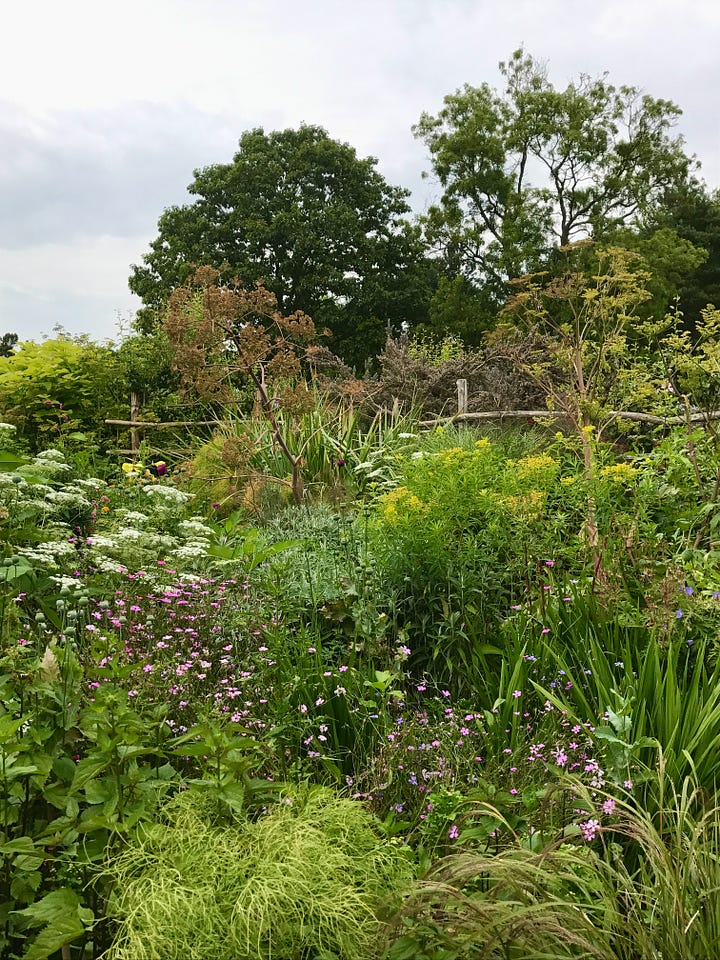
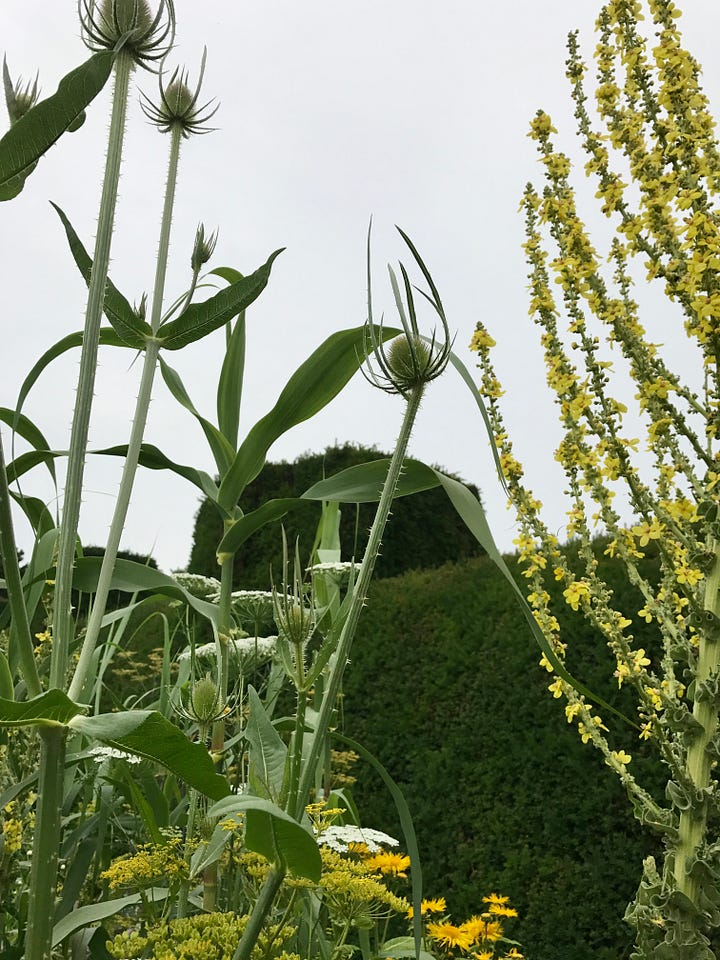
Julie: How has Great Dixter inspired you?
Helen: The exuberance of plantings, the careful planning over months and years, coupled with absolute spontaneity & collaboration. There is such care in planning combinations, planning out planting plans sometimes years in advance. It is a thrill to sow seeds in March that will be planted in the borders that coming fall, or possibly the following spring. So much care and attention to detail all the time.
And then also, with all that planning, sometimes you just see Fergus get a new idea, see something looking great in the nursery, and then throw it into the mix at the last minute. He also might ask another gardener out of the blue what they think, what they might add, and sometimes he goes with those ideas as well. When I am planning gardens or planting plans, I always (sub)consciously leave a good 20% for last minute add ons, whatever is looking great or fun at the moment to add to the mix. I also like to ask my crew and fellow gardeners their opinions, let them choose some of the plants to bring to jobs, and let them plant them the way they see it. I learn so much from the people I am working with. Being open and inspired by what's around you (and who you are with) all the time is maybe the best thing Great Dixter gave me.
Julie: What three words best describe Great Dixter to you?
Helen: Full of feeling (is there one word for that sentiment?)
All-encompassing
Unexpected


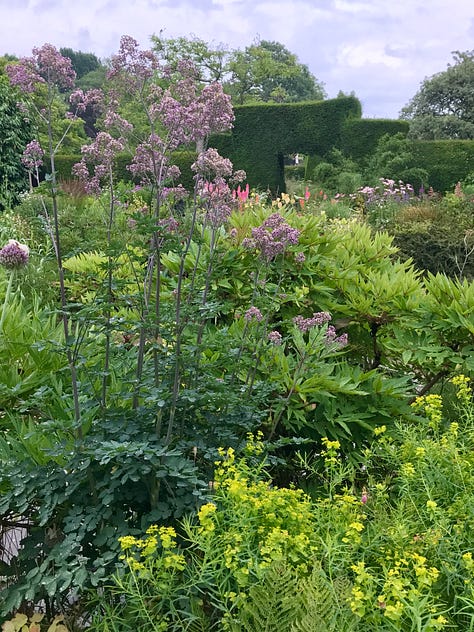
Julie: How have you applied what you have learned at/from Dixter to your gardening & nursery business in North America?
Helen: One major principal that I’ve carried with me is the importance of design, maintenance, and growing being three main things that go hand in hand—they all inform each other. And so I’ve built my business around doing those three things with the help of my amazing employees and friends to help me achieve these goals. Do the work and keep learning.
The other core lessons for me are to always be creative, open-minded, curious, and thoughtful about cause and effect. Sometimes as you create something you are disturbing something else, just tidying up can sometimes take apart something that is so spontaneously beautiful. There is so much chaos in nature, in plants and insects relationships, in building habitats & creating beauty, it’s a real push/pull.
I think as gardeners we are always evaluating the “right time” to cut the garden back, to mow the grass, to turn the soil, to plant, to prune; we are constantly weighing the harm with the good. I always think about what Christopher Lloyd said when asked when is the right time to prune. I think he answered, the right time is when you have the time! I try not to be too dogmatic about any of it, and mostly just try to listen to the garden, to the land, to the plants & creatures, to the way it all makes me feel—it is always changing. Trusting my instincts, following my interests, and really loving the world around me is what it is all about.
“I try… to listen to the garden, to the land, to the plants & creatures, to the way it all makes me feel…”🌿
Helen O’Donnell on Great Dixter
Julie: Where can we find out more about your work in North America?
Helen: I post really irregularly on Instagram, Bunker Farm Plants, you can email me to join my email list (I email about 3 times a year regarding my nursery!) bunkerfarmplants@gmail.com. Sometimes the gardens I’ve worked on or designed are open for Open Days. Someday I might have a website!
Come visit me at Bunker Farm, and I will show you around!
“Being open and inspired by what's around you all the time, and who you are with, is maybe the best thing Great Dixter gave me.”
🌿 Helen O’Donnell on Great Dixter
Thank you, Helen, for sharing your Great Dixter story today!
Read more about Helen O’Donnell:
Helen on my old garden blog, Wife, Mother, Gardener
Helen’s old blog, Anemone Times
Which of Helen’s lessons from Great Dixter could apply most to your own gardening? Love to hear!
Other interviews in this series about Great Dixter’s influence on North American gardeners:
The Generosity of Great Dixter
“The great thing is not to be timid in your gardening, whether it's colours, shapes, juxtapositions or the contents themselves. Splash around and enjoy yourself. If you buy a banana, it'll not be for its fruit (go to the greengrocer for that) but for its huge leaves. There are some fantastic kinds around …





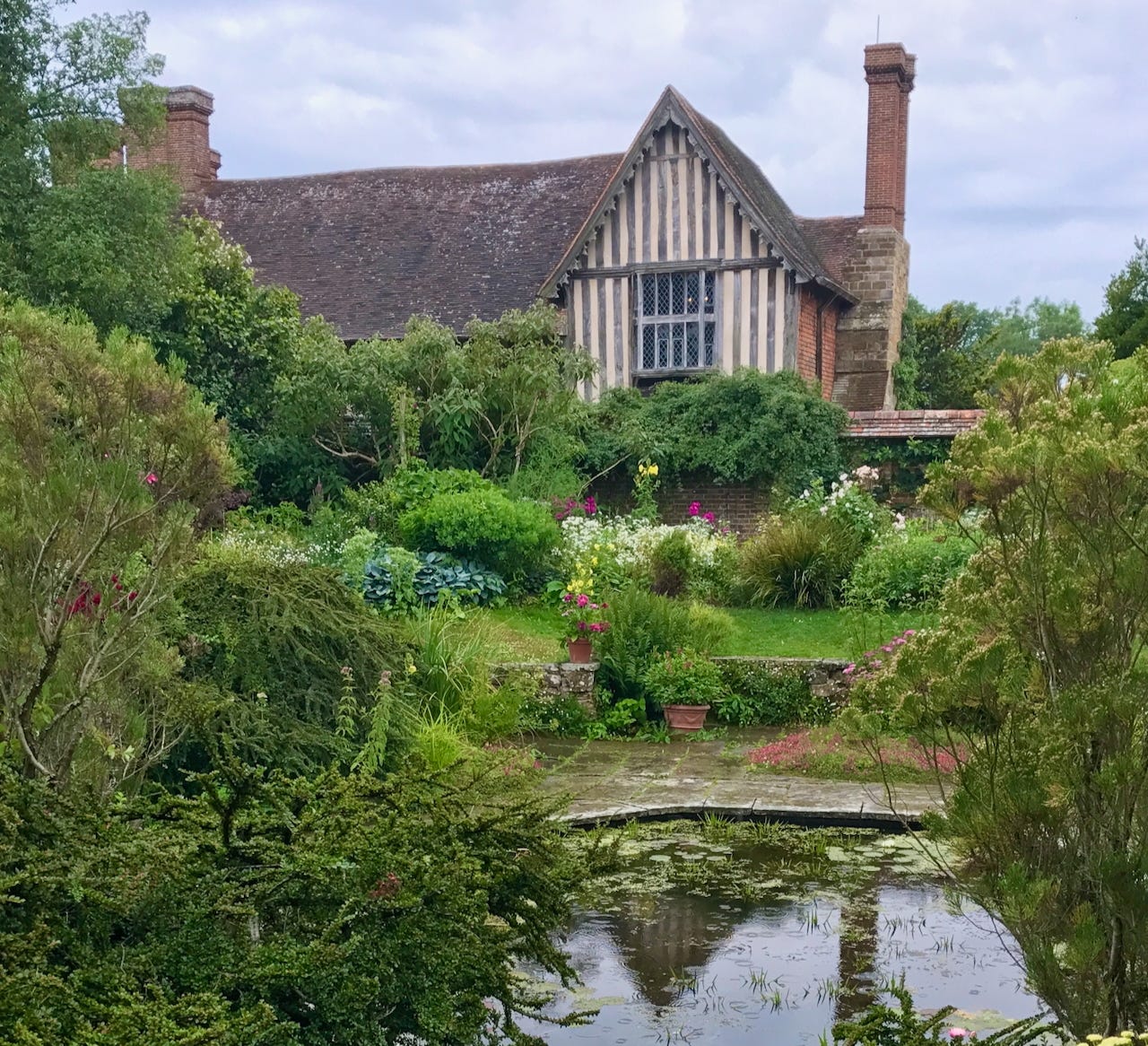
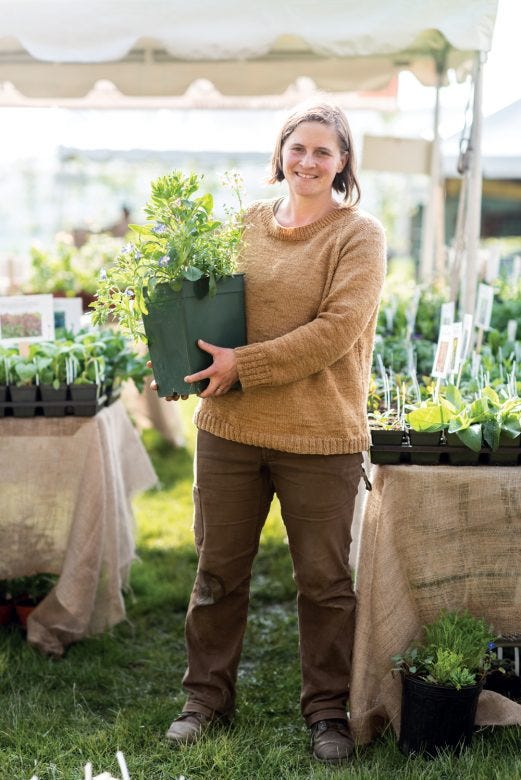

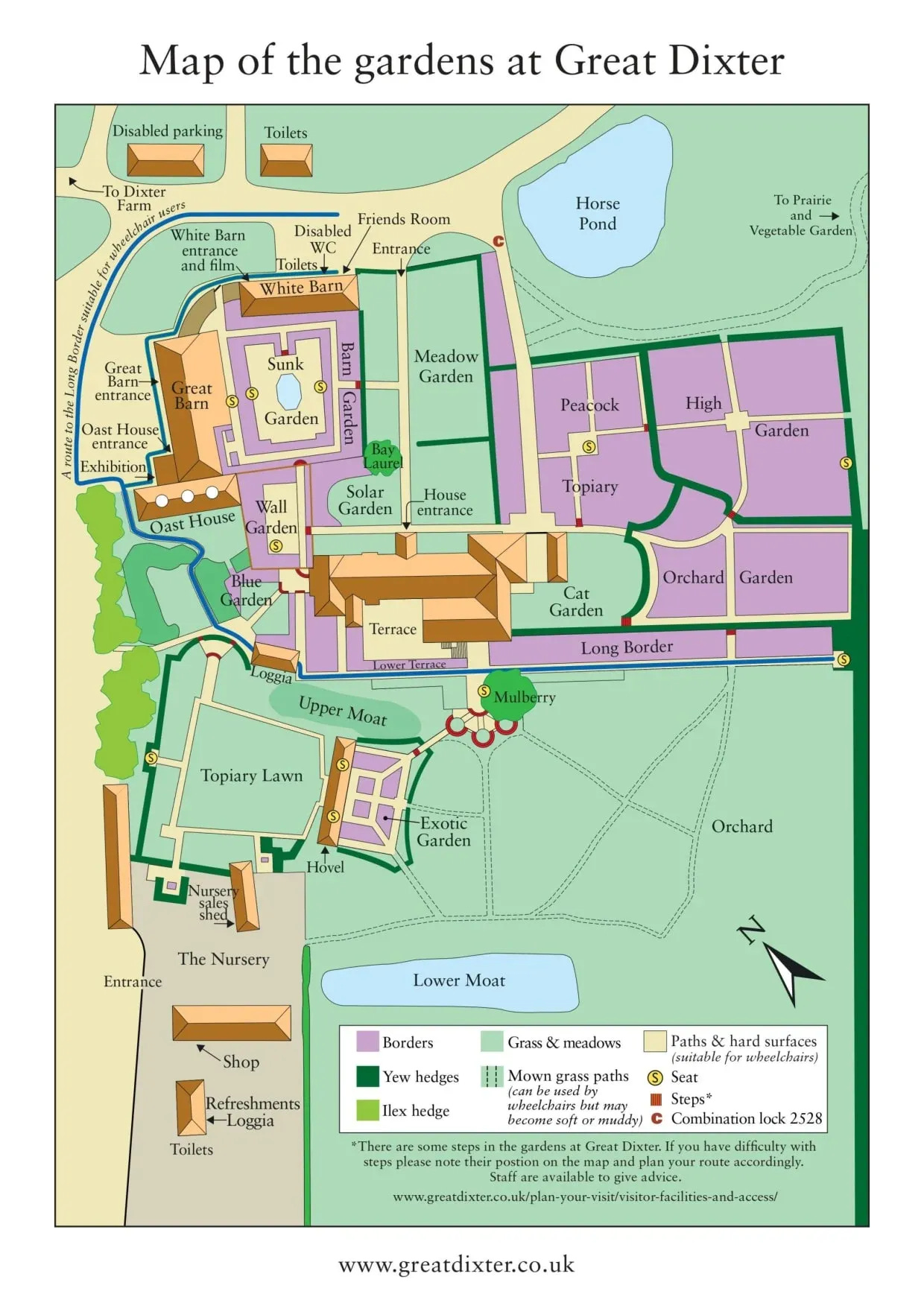








Fantastic article, Julie. Full of information. My daughter and I are going to Great Dixter in April. I can't wait!
I really enjoyed the interview. I've visited Great Dixter several times so this resonates. Always wished I could visit Helen, but that's a long way from here.